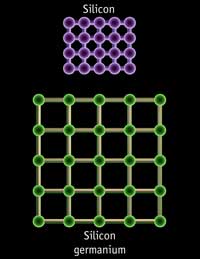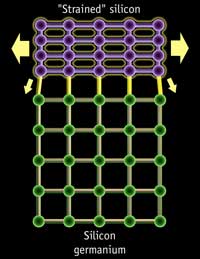Intel's Pentium 4 E: Prescott Arrives with Luggage
by Anand Lal Shimpi & Derek Wilson on February 1, 2004 3:06 PM EST- Posted in
- CPUs
Something to be proud about
Intel is particularly proud of their 90nm process as it incorporates new technologies that are a first in desktop microprocessors. The biggest of them all is the use of Strained Silicon, which we explained back in August of 2002 when Intel first announced that they would use the technology:
Strained Silicon works by effectively stretching the silicon in the channel region of the transistor. The engineers at Intel's fab facilities don't sit there and pull on both ends of the silicon in order to get it to stretch; rather they place the silicon on top of a substrate whose atoms are already spaced further apart than the silicon that needs to be stretched. The result of this is that the silicon atoms on top of the substrate will stretch to match the spacing of the substrate below, thus "stretching" the silicon in the channel.
 |
 |
|
Silicon is "strained" by using a substrate of more widely spaced atoms below the silicon channel of a transistor. (Images courtesy of IBM) |
|
With more well spaced silicon atoms, electrons can now flow with less resistance in the channel meaning that more current can flow through the channel when needed. The end result is a 10 - 20% increase in drive current, or the current flowing through the channel of the transistor.
![]()
Intel claims that their Strained Silicon technology has no real downsides (unlike competing solutions) other than its 2% increase in manufacturing costs. Intel's 90nm process will make use of Strained Silicon technology to improve the performance of their 90nm transistors.
Intel’s 90nm process does not make use of Silicon on Insulator and according to their manufacturing roadmaps it never will. Intel will introduce SOI on their 65nm process in 2005.

Prescott's 112 mm^2 die
Prescott is Intel’s first desktop microprocessor to have 7 metal layers, 2 fewer layers than AMD’s Athlon 64. Intel had to add the 7th layer simply because of the skyrocketing transistor count of Prescott (125 million vs. Northwood’s 55 million). It’s not normally desirable to increase the number of metal layers you have on a chip as it increases manufacturing complexity and cost, but in some cases it is unavoidable. The fact that Intel was able to keep the number of metal layers down to 7 is quite impressive, as AMD had to resort to 9 layers dating back to the introduction of their Thoroughbred-B Athlon XP core to keep clock speeds high.
|
CPU Core Comparison |
|||||
| Code Name |
Willamette |
Northwood |
Northwood EE |
Prescott |
AMD Athlon 64 |
| Manufacturing Process |
0.18-micron |
0.13-micron |
0.13-micron |
90 nm |
0.13-micron |
| Die Size |
217 mm^2 |
131 mm^2 |
237 mm^2 |
112 mm^2 |
193 mm^2 |
| Metal Layers |
6 |
6 |
6 |
7 |
9 |
| Transistor Count |
42 Million |
55 Million |
178 Million |
125 Million |
105.9 Million |
| Voltage |
1.750V |
1.50V |
1.50V |
1.385V |
1.50V |
| Clock Speeds |
1.3 - 2.0GHz |
1.6 - 3.4GHz |
3.2 - 3.4GHz |
2.8 - 4GHz+ |
2.0GHz+ |
| L1 Instruction/Trace Cache | 12K µops |
12K µops |
12K µops |
12K µops |
64KB |
| L1 Data Cache | 8KB |
8KB |
8KB |
16KB |
64KB |
| L2 Cache | 256KB |
512KB |
512KB |
1MB |
1MB |
| L3 Cache | N/A |
N/A |
2MB |
N/A |
N/A |










104 Comments
View All Comments
INTC - Monday, February 2, 2004 - link
Ummmm yea, kinda reminds me of cooking an egg on an Athlon XP http://www.biggaybear.co.uk/Menu/Aegg/Aeggs.htmlcliffa3 - Monday, February 2, 2004 - link
something good to include on the mb compatibility article would be what boards would house the 2.8/533...i'm wondering myself if the E7205 chipset would...i have a p4g8x, and it would be a welcome upgrade with HT and all the other goodies if it oc's well.Stlr22 - Monday, February 2, 2004 - link
They didn't burn down, but the proc were running hot. Not to mention, these are the FIRST releases in the Prescott line. What's it gonna be like later on?....Just think, a P4 based computer that turns your living room into your very own Sauna!!....WHOOO-HOOO!!.....now that's what I call a bargain!
INTC - Monday, February 2, 2004 - link
The message is clear: Anandtech and all of the other review sites didn't burn down so I guess it's not a flame thrower.Prescott is not as fast as I had hoped but is definitely not the step backwards as some were rumoring it to be. I think a Prescott 2.8 @ 250 MHz FSB will be really nice to play with until I see what Intel announces at IDF in a few weeks.
Icewind - Monday, February 2, 2004 - link
The message is clear: Im buying an Athlon 64.Vanners - Sunday, February 1, 2004 - link
Did anyone catch the error in Pipelining: 101?if you halve the time for a stage in the pipeline and double the number of stages. Yes this means you can run at 2GHz instead of 1GHz but the reality is you're still taking 5ns to complete the pipe.
Look at it like a motorbike: You drop down a gear and rev harder; you make more noise but you are still doing the same speed.
The only reasons to drop down a gear are to break through your gears (i.e. slow down) or to rev significantly higher than the change in gear ratio in order to move faster (with more torque).
The trouble Intel has is that they drop down a gear then rev 6 months to a year later.
kamper - Sunday, February 1, 2004 - link
Just curious, Anand or Derek: what board did you use to get the 3.72 GHz oc? Obviously it wasn't the intel board used in the benches. I guess we'll hear all about this in the compatibility review though :)keep up the good work, that last point about smaller margins at higher clockspeeds (vs. Northwood) was cool. Let's just hope the pattern continues.
Stlr22 - Sunday, February 1, 2004 - link
Seems to me like people either got cought up in some of the hype and expected to much or some people expected to little and that history would repeat itself (Willamette vs Palomino)The fact that the Prescott fared much better in it's launch compared to the Willamette might be a hint to not underestimate it. Prescott isn't really looking bad now, and I think it will hit stride faster then the Willamette core did.
The next couple of years are gonna be really interesting.
Damn, ya just gotta love it!
ntrights - Sunday, February 1, 2004 - link
Great review!KF - Sunday, February 1, 2004 - link
I've grown to appreciate CRAMITPAL. If you read around the opinionated diatribes, he has some good stuff that people avoid saying for fear of retaliation. I suppose if I were in love with Intel, he would tick me off.But, it does look like Intel has created a CPU that should ramp up to speeds high enough to beat the A64 in 32bit mode, and that is all they needed to do.
Regardless of how much heat that is going to take, Intel must have some way in the works to handle it.
Looks like they might not charge an arm and leg for it, which is the biggest shock.